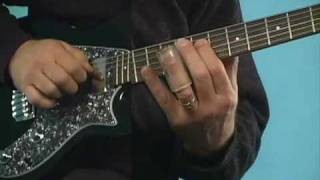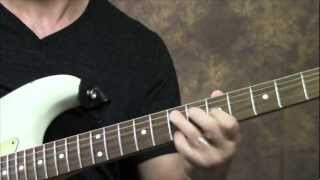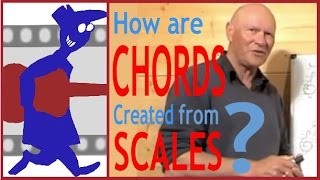Pentatonic Theory
Published on 26 January 2016
For more information from the source site of this video please visit: http://secretguitarteacher.com/youtube/advanced/theory/pD2VC7ZXOsk/84410833-pentatonic-theory.php
WARNING, NOT FOR BEGINNERS!
This is a lesson from part 3 of the Secret Guitar Teacher's Guitar Music Theory Course. In its original context it is studied late on the course and therefore assumes a fair amount of music theory knowledge about chord construction, the diatonic series, circles of fourths and fifths etc.
Also, on the site it appears with a 'toolbox' that gives you access to printouts that go with the video lesson.
So please enjoy watching it as a sample from this course and do click through to the site if you would like to know more, or email me if you have any questions.
Here's the abridged transcript:
If you have spent any time at all playing lead guitar, then there is a very high probability that you have used the pentatonic scales. But, it is relatively rare to find a guitarist who can explain why these scales work so well. First off, let's look at the most basic way of deriving a pentatonic scale:
You take a circle of fifths: pick a note to start on as a key note -- we'll pick C to show you the easiest example to start with. Then you add to it the next four notes round the circle so we have picked out the notes C G D A and E.
Then, starting with the key note, we arrange these five notes in musical alphabetical order...and that gives us the notes of the Major pentatonic scale in that key. In this case the C major pentatonic scale.
If we then take the last note of the major pentatonic scale, in this case A...and bring it round to the start of the scale, we have the notes of the Minor pentatonic scale in the relative key.
For every note on the circle of fifths; which we normally diagram as going round the outer edge of a circle in a clockwise direction, there's an enharmonic equivalent note -- one that sounds the same, but is named differently, that we see as being on the circle of fourths.
This circle of fourths is traditionally shown as moving anti-clockwise round the inside of the circle of fifths.
One of the ways we might use this is to find the names of pentatonic scale notes in some of the more awkward keys like Bb Major for example:
Notice how I start on the Bb, a note which can only be found in the inner circle, but as soon as I hit notes that have more complex sounding names like Dbb, Abb and Ebb, I jump across to the equivalent notes in the outer circle.
This process gives me the names of the notes, both in the Bb major pentatonic and its relative G minor pentatonic.
Another simple way is to work backwards from the Major scale...and simply remove the fourth and seventh notes of the scale. Likewise, we can see the minor pentatonic as a natural minor scale that leaves out its 2nd and 6th notes..
One more way to look at the pentatonic scales that I actually find the most useful in practice is to think of them as arpeggios of five-note chords.
For example, if you take the notes of the C major pentatonic scale...and pile them up in a certain order; by taking the second note up an octave so that it becomes the ninth note; you get a jazz chord, the C 6/9th chord. Its formula is 1 3 5 (the major triad) followed by 6 to make a major sixth chord and then the 9th note on top to make the Major 6/9th. The 6/9 can make a nice smoochie ending chord in place of a major or maj7 follow a typical ii V I jazz sequence like: Dm7 G7 Cmaj7 with Dm9 G13 C6/9
Likewise the relative minor pentatonic scale notes can be seen to make a Minor Seven 11th chord. Its formula is 1 b3 5 (the minor triad) followed by the b7th to make a minor seventh chord and the 4th note played in the upper octave to make the 11th.
Now, talking of blues, let's have a look at how we turn a minor pentatonic scale into a blues scale. As you can see there is only one note difference. A blues scale can be seen as a minor pentatonic with an added b5.
This gives us a rather interesting scale when you think about the way in which these notes from the blues scale ...are used to improvise over progressions using these three chords ...the 1 4 5 chords. If we look closely at the blues scale in A for example, you can see that every other note, here shown in red, is a root note of one of the 1 4 5 chords A D and E. And in between these notes, the notes shown in blue are the non-diatonic notes, the b3, b5 and b7. We actually refer to these as blue notes.
We can clearly hear how these notes play off against each other in blues phrasing.
So, that is a quick look at the pentatonic scales and one of their derivatives the blues scale, from a few different angles just to get you thinking about it in a variety of different ways.
In the next lesson, we'll look at how we can put this thinking to good use.
I look forward to seeing you then.
 Guitar Lesson: Standard Tuning Slide Lick
Guitar Lesson: Standard Tuning Slide Lick
 Diminished Chords - How to Play them on the Guitar...
Diminished Chords - How to Play them on the Guitar...
 Creative Arpeggio Design - Hybrid Picking Approach...
Creative Arpeggio Design - Hybrid Picking Approach...
 The "Each Finger First" Chord-Changing Exercise
The "Each Finger First" Chord-Changing Exercise
 How to Play Guitar Melodically
How to Play Guitar Melodically
 Marty Schwartz Guitar Solo Lesson - Solo Concepts...
Marty Schwartz Guitar Solo Lesson - Solo Concepts...
 A Beautiful Muse Chord Progression
A Beautiful Muse Chord Progression
 How to Embellish an E Chord
How to Embellish an E Chord
 How to make your own chords on the guitar - Part 1
How to make your own chords on the guitar - Part 1
 Four Note Solo Over Four Chords | Guitar Lesson |...
Four Note Solo Over Four Chords | Guitar Lesson |...







